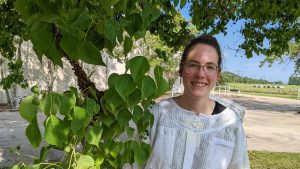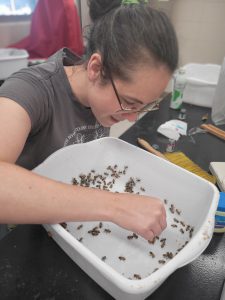By: Pierre Lau
This article was originally published in Entomology Today.

Elizabeth (Liz) Walsh, Ph.D., is a research scientist with the U.S. Department of Agriculture’s Agricultural Research Service (USDA-ARS), in the Honey Bee Breeding, Genetics, and Physiology Research unit in Baton Rouge, Louisiana. Here, Walsh poses beside a small honey bee swarm on a tree branch on her first day at the USDA-ARS in May 2022. (Photo by Kate Ihle)
This article is part of the “Standout ECPs” series contributed by the Entomological Society of America’s Early Career Professionals (ECP) Committee, highlighting outstanding ECPs that are doing great work in the profession. (An ECP is defined as anyone within the first five years of obtaining their terminal degree in their field.) Read past articles in the Standout ECPs series.
Elizabeth (Liz) Walsh, Ph.D., is a research scientist with the U.S. Department of Agriculture’s Agricultural Research Service, in the Honey Bee Breeding, Genetics, and Physiology Research unit in Baton Rouge, Louisiana.
She completed a postdoctoral fellowship in 2022 with Agriculture and Agri-Food Canada under the guidance of Steve Pernal, Ph.D., of at the Beaverlodge Research Farm in Alberta. During that fellowship she explored the links between honey bee health challenges and honey bee biomarkers as a part of the national BeeCSI project, and she also did work with American foulbrood and chalkbrood, exploring stock variation, asymptomatic versus symptomatic infections, and more.
In contrast, for her Ph.D. at Texas A&M University, completed in 2019 under guidance of Juliana Rangel, Ph.D., Walsh explored the impact of miticide exposure in immature honey bee queens. For her bachelor’s degree, received in 2014, Walsh double majored in English and biology at Ripon College in her home state of Wisconsin.
Walsh says she is pleased to be well into her “teenage” years as a beekeeper, since she began keeping bees as a young high school student, and she is proud to serve the beekeeping industry through research initiatives. At USDA-ARS, she is currently working on various projects that include examining aggression due to environmental stressors, different responses within various honey bee stocks, drone reproductive health and biology, queen reproductive health after stressor exposure, and honey bee variation in responses to pathogens.
Lau: How did you become
interested in entomology?
Why honey bees?
Walsh: Honey bees were my entry into entomology. I began keeping bees as a young high school student, and it took over my life. I kept colonies throughout my time as a high school and undergraduate student as a source of income to pay for my undergraduate tuition. I didn’t know much about bees initially, but the more I learned the more interested I was. I didn’t really think of graduate school as an option for me because I didn’t know people that had gotten graduate degrees in STEM, but an undergraduate biology advisor encouraged me to consider pursuing my interest in honey bees as a graduate studies topic.
The simultaneous complexity and simplicity of honey bee biology really appeals to me. One of my favorite things about honey bees is that diploid eggs are bipotent, so any female egg can become either a worker or a queen, depending on what care they receive as a young larvae. It’s also just generally fun to play with drones since they are so buzzy but have no stingers, which can make for fun outreach events with kids who can actually handle honey bees and learn not to be scared of them. At the end of the day, there’s so much yet to learn, and it’s fun to be able to figure out what is “wrong” with colonies and what strategies beekeepers can do to improve their colony health and survivorship.
Can you talk about your current research with the USDA? What is your favorite part about it?
I’ve got a lot of different experiments going right now, which I jokingly refer to as “new PI syndrome,” where you take on too many cool projects at once. One of my favorites is the “hangry” bee project. Beekeepers and scientists tend to think of honey bee temperament as a genetic component of a bee colony, and genetics definitely plays a role in something like aggression, but we showed that the environment can also play a significant role in colony temperament too by simulating a nutrient dearth.
I’m also working on various honey bee stock assessments in varying environments, which will hopefully tell us a little bit more about how the environmental context plays into colony success and health. This Summer my lab is also continuing work that looks at honey bee disease ecology to develop sustainable pest management solutions.

Elizabeth (Liz) Walsh, Ph.D., marks one-day old bees with paint—or, as she calls it, “Picassoing” them—for an age-dependent study. (Photo by Mike Simone-Finstrom)
I think my favorite part about working at the USDA-ARS as a research entomologist is that I get to work with fantastic colleagues and steer my research wherever I want within the bounds of my unit’s research mission, which is to examine honey bee breeding, genetics, and physiology. That gives me a lot of room to do interesting things.
Can you describe the transition from graduate school to postdoc and your current position as a research entomologist? Was there anything you were surprised to learn about?
My transition from graduate school to postdoc was made possible by the 2019 ESA Annual Meeting, which was where my future postdoc advisor approached me to ask if I would be available or had interest in doing a postdoc at their location. My advisor and I were acquainted because we’d both attended the same conferences and seen each other’s presentations over several years, so we were at least vaguely aware of each other’s work and what the other was capable of, and a mutual colleague had also suggested me since they knew I was searching for a position.
The thing that surprised me was how quickly it went. I went from being extremely anxious in November of that year I still didn’t have a concrete position for after graduation, which was in December, to essentially interviewing and getting an offer in November and then making the international move from Texas to northern Alberta in February. Something that sticks out to me is how important it was that my postdoc advisor and I were already familiar with each other after attending the same conferences and being active participants before he had the position available or I was actively looking for a position.
My transition from postdoc to my current position went very slowly initially, as I got into the federal system and then applied, interviewed, and on-boarded, but then it went really quickly to physically move from Alberta to Louisiana and actually start.
I guess the surprise for me about that career stage was a lesson in timing of publications. My graduate work got published fairly quickly, in part because I was the main person of a small group of co-authors. During my postdoc, I was fortunate enough to work with large groups of wonderful people, which made the work go faster and be stronger, but it definitely slowed down the publication process. I’m excited to report that some of those papers will be available soon!
Is there a tool or skill that you would consider essential for your field?
My work is very applied, and I think that, for any applied research to really conclude, it has to be effectively communicated to both scientific and stakeholder audiences, so I would consider good communication skills essential.
What would you tell your graduate-student self if you could go back in time?
That it all works out well and I eventually got my dream job! Just the reassurance would have meant a lot to me as a graduate student without much confidence.
Do you have any tips on how you manage your work-life balance?
That’s a hard one. Because so much of my work is centered around a field season, I know that I have intense times of the year and that I’ll have less intense times of the year. During the less intense times, I tend to take as much time as I can to mentally rest up for field season and put my best effort into it.
I also think that, at the end of the day, it’s just a job, and I try to remember that. I love my job and my colleagues, which normally makes it a very fun job, but I try to mentally keep my priorities straight between my job and my family or health. One example is that I try to keep my work physically at work and my home work-free. Every so often that doesn’t happen, but it helps me to largely keep things physically separate.
What is the coolest thing you wish other people knew about your job?
I have an observation hive in my office! It’s such a neat reminder to keep the bee biology in mind and to generate ideas. It’s also fun to see everyone’s enthusiasm when visitors come to see it.
It is also consistently cool to me that I head my own lab and can choose my own research directions. I’ve been able to take ownership and keep autonomy over my research topics in a way that I think people don’t associate with USDA jobs, which is unfortunate because I think it makes potential candidates not fully consider federal positions.
What is your spirit arthropod and why?
Hahaha, not sure! Maybe a cicada because my work periods are quite cyclic and sometimes involve cathartic vocal venting when bees misbehave—haha!
Thank you, Liz! Learn more about Walsh and her research on Google Scholar, ResearchGate, LinkedIn, or her USDA-ARS profile.
Pierre Lau, Ph.D., is a research ecologist at U.S. Department of Agriculture’s Agricultural Research Service in Stoneville, Mississippi, and the 2023-2025 Southeastern Branch representative to the ESA Early Career Professionals Committee. Email: pierre.lau@usda.gov.
